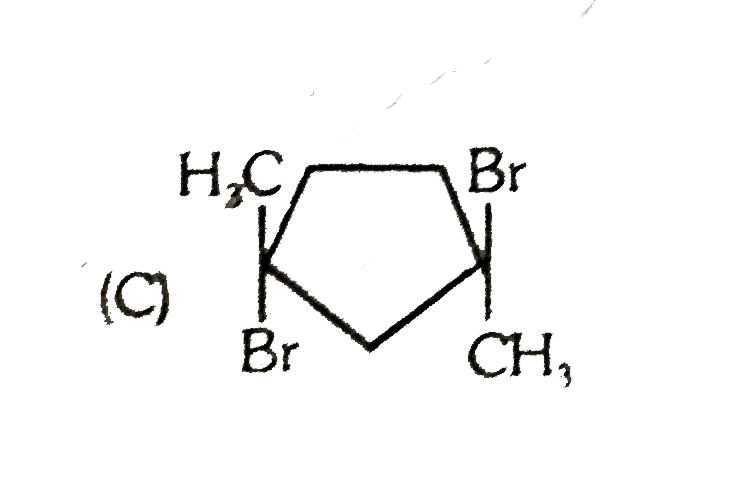An optically active compound A (assume dextrorotatory) has the molecular formula C7H11Br. A reacts with hydrogen bromide, in the absence of peroxides to yield isomeric products, B and C, with the molecular formula C7H12Br2. Compound B is optically active, C is not. Treating B with 1 mol of potassium butoxide yields (+)−A. Treating C with 1 mol of potassium tert-butoxide yields (±)−A. Treating A with potassium tert-butoxide yields D(C7H10). Subjecting 1 mol of D to ozonolysis followed by treatement with zinc and acetic acid yields 2 moles of formaldehyde and 1 mole of 1,3-cyclopentanedione.

The compound 'B' is:




The correct Answer is:C
Step by step video & image solution for An optically active compound A (assume dextrorotatory) has the molecular formula C_(7)H_(11)Br. A reacts with hydrogen bromide, in the absence of peroxides to yield isomeric products, B and C, with the molecular formula C_(7)H_(12)Br_(2). Compound B is optically active, C is not. Treating B with 1 mol of potassium butoxide yields (+)-A. Treating C with 1 mol of potassium tert-butoxide yields (+-)-A. Treating A with potassium tert-butoxide yields D(C_(7)H_(10)). Subjecting 1 mol of D to ozonolysis followed by treatement with zinc and acetic acid yields 2 moles of formaldehyde and 1 mole of 1,3-cyclopentanedione. The compound 'B' is: by Chemistry experts to help you in doubts & scoring excellent marks in Class 12 exams.
Updated on:21/07/2023Topper's Solved these Questions
- ALKYL AND ARYL HALIDEBOOK - ALLENCHAPTER - ALKYL AND ARYL HALIDEEXERCISE - EXERCISE-02
1 Videos
- ALKYL AND ARYL HALIDEBOOK - ALLENCHAPTER - ALKYL AND ARYL HALIDEEXERCISE - EXERCISE-04 [A]
1 Videos
- ALKYL AND ARYL HALIDEBOOK - ALLENCHAPTER - ALKYL AND ARYL HALIDEEXERCISE - EXERCISE-01
1 Videos
- ALKENE, ALKANE & ALKYNE BOOK - ALLENCHAPTER - ALKENE, ALKANE & ALKYNE EXERCISE - EXCERSISE-3
28 Videos
- Atomic StructureBOOK - ALLENCHAPTER - Atomic StructureEXERCISE - All Questions
62 Videos
Similar Questions
An optically active compound A (assume dextrorotatory) has the molecular formula C7H11Br. A reacts with hydrogen bromide, in the absence of peroxides to yield isomeric products, B and C, with the molecular formula C7H12Br2. Compound B is optically active, C is not. Treating B with 1 mol of potassium butoxide yields (+)−A. Treating C with 1 mol of potassium tert-butoxide yields (±)−A. Treating A with potassium tert-butoxide yields D(C7H10). Subjecting 1 mol of D to ozonolysis followed by treatement with zinc and acetic acid yields 2 moles of formaldehyde and 1 mole of 1,3-cyclopentanedione.

The optically active compound 'A' is
View SolutionDraw all structurally isomeric cyclic bromides with molecular formula C4H7Br.
View Solution
Knowledge Check
An optically active compound A with molecular formula C8H14 undergoes catalytic hydrogenation to give meso compound, the structure of (A) is :
A B
B C
C D
D
A compound with molecular formula C7H16 shows optical isomerism, the compound will be
View SolutionAn optically active hydrocarbon X has molecular formula C6H12. X
on catalytic hydrogenation gives optically inactive C6H14.X
could be
View SolutionWhich of the compounds with molecular formula C5H10yields acetone on ozonolysis ?
View SolutionAn optically active compound A with molecular formula C8H14 undergoes catalytic hydrogenation to give an optically inactive product. Which of the following structures for A is/are consistent with all the data?
View SolutionAn optically active compound 'X' has molecular formula C4H8O3. It evolves CO2 with NaHCO3. 'X' reacts with LiAIH4 to give an achiral compound 'X' is:
View SolutionWrite the structures and names of the compounds formed when compound 'A' with molecular formula C7H8 is treated with Cl2 in the presence of FeCl3
View SolutionWhen H2 is added to two isomeric alkenes A and B having molecular formula C5H9Cl, A gives optically inactive compound while B gives a chiral compound. The two isomers are
View Solution
